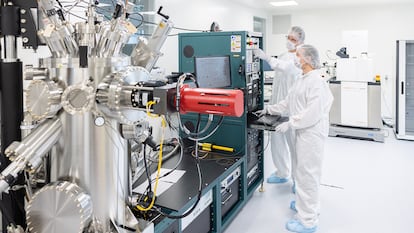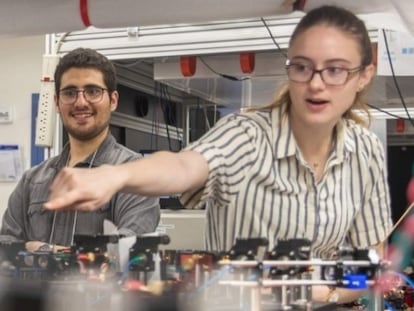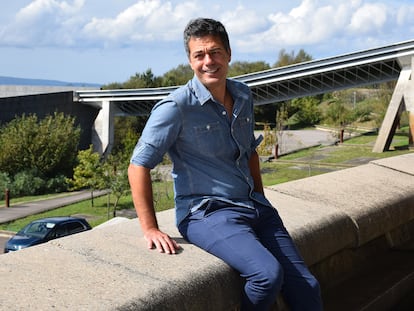The race is on for a new internet based on quantum physics
Europe is working to create a network infrastructure that can transmit information more securely

In May 2023, Dr Benjamin Lanyon at the University of Innsbruck in Austria took an important step toward creating a new kind of internet: he transferred information along an optical fiber 31 miles (50 kilometers) long using the principles of quantum physics.
Information in quantum physics differs from the units of data – binary digits – stored and processed by computers that form the core of the current World Wide Web. The quantum physics realm covers the properties and interactions of molecules, atoms and even smaller particles such as electrons and photons.
Particle power
Quantum bits, or “qubits,” offer the promise of transmitting information more securely because the particles get changed by the act of observing and measuring them. That means an eavesdropper can’t go undetected.
Lanyon said his work makes the quantum internet appear feasible within cities, after which longer intercity distances will be the goal.
“You could imagine this being a large-city scale,” he said.
His breakthrough was part of an EU research project to bring the goal of a quantum internet closer.
Called the Quantum Internet Alliance, or QIA, the project brings together research institutes and companies across Europe. The initiative is receiving €24 million in EU funding over three and a half years until the end of March 2026.
“It is not meant to replace the classical internet, but to work together,” said Stephanie Wehner, a German native who coordinates the QIA and is a professor of quantum information at Delft University of Technology in the Netherlands. “We’re not going to replace Netflix.”
A key concept in quantum physics is entanglement. If two particles are entangled, no matter how far apart they are in space, they will possess similar properties – for example, both having the same measurement of something called “spin”, a quantum version of the direction that the particles are spinning.
The spin state of the particles isn’t clear until they are observed. Until then, they’re in multiple states called superposition.
But when one is observed, the state of both particles becomes known.
Possibilities aplenty
This is useful in secure communications. People hacking a quantum transmission would leave behind an obvious trace of their attempt by causing a change in the state of an observed particle.
“We can use the properties of quantum entanglement to achieve a means of secure communication that is provably secure even if the attacker has a quantum computer,” said Wehner.
The secure communications afforded by a quantum internet could open up a much broader range of applications that are well beyond the bounds of the classical internet.
In medicine, for example, the physics of entanglement allows for a level of clock synchronization that can improve telesurgery.
“If I want to perform surgery on some remote node, I want this to be very precisely timed in order to not make any mistakes,” said Wehner.
Astronomy is another potential beneficiary.
Telescopes making distant observations could “use a quantum internet to generate entanglement between the sensors to get a much better image of the sky,” Wehner said.
A further example might be ATM machines.
At present, were an ATM to crash when a person was withdrawing money, the machine would assume no cash had been delivered while another dispenser would register a money withdrawal. A quantum internet could remove that discrepancy.
Many applications of a quantum internet will likely become apparent only after the technology is created.
“It offers a whole range of new possibilities for making precise measurements of space and time and studying how the world and the universe work,” said Lanyon.
Distance test
The trick now is scaling up a quantum internet to use many particles across long distances.
Lanyon and his team have also demonstrated communicating not just between single particles but also ‘trains’ of particles – in this case light particles called photons – speeding up the rate of entanglement between quantum nodes.
“If you just sent one photon at a time, you have to wait for the travel time,” he said. “But if you can make trains of many photons at once, this allows you to increase the rate of entanglement between quantum nodes for the distances we want.”
The ultimate goal is to extend quantum nodes to much bigger ranges, perhaps 310 miles (500 kilometers), and create a prototype of a quantum internet that can link remote cities – much like the classical internet relies on different nodes to create a global internet.
While a quantum internet could exist for specialized applications as soon as 2029, experts are wary of hazarding a guess about when a full version might be available for a wide range of uses.
As the QIA advances the components and systems of the quantum internet, Europe is also working to develop quantum computers themselves.
In June 2023, an EU public-private partnership – the European High Performance Computing Joint Undertaking – announced that six countries in Europe would host quantum computers. The countries are the Czech Republic, France, Germany, Italy, Poland and Spain.
The aim is to ensure that Europe is at the forefront of the quantum technologies revolution. Quantum computers are expected to have unprecedented calculation power with many uses, including the ability to break the cryptographic algorithms that secure most of the exchanges of the current internet.
Crowded field
With projections that half of the most used cryptographic systems will be broken by the end of the decade, Europe is hardly the only interested party.
China and the US have made advances in quantum computing and the quantum internet in recent years.
Back on the infrastructure front, Europe is taking other steps. It’s developing an integrated space and terrestrial infrastructure for secure communications – a building block of sorts for the quantum internet.
“I’m very proud to say we are world-leading in many domains,” said Wehner.
While in all interested countries much work remains, the potential benefits signal further advances and breakthroughs before too long.
“People are developing new applications of quantum networks at quite a high rate,” Lanyon said.
Research in this article was funded by the EU. This article was originally published in Horizon, the EU Research and Innovation magazine.
Sign up for our weekly newsletter to get more English-language news coverage from EL PAÍS USA Edition
Tu suscripción se está usando en otro dispositivo
¿Quieres añadir otro usuario a tu suscripción?
Si continúas leyendo en este dispositivo, no se podrá leer en el otro.
FlechaTu suscripción se está usando en otro dispositivo y solo puedes acceder a EL PAÍS desde un dispositivo a la vez.
Si quieres compartir tu cuenta, cambia tu suscripción a la modalidad Premium, así podrás añadir otro usuario. Cada uno accederá con su propia cuenta de email, lo que os permitirá personalizar vuestra experiencia en EL PAÍS.
¿Tienes una suscripción de empresa? Accede aquí para contratar más cuentas.
En el caso de no saber quién está usando tu cuenta, te recomendamos cambiar tu contraseña aquí.
Si decides continuar compartiendo tu cuenta, este mensaje se mostrará en tu dispositivo y en el de la otra persona que está usando tu cuenta de forma indefinida, afectando a tu experiencia de lectura. Puedes consultar aquí los términos y condiciones de la suscripción digital.
More information
Archived In
Últimas noticias
Mustafa Suleyman: ‘Controlling AI is the challenge of our time’
Venezuela breaks energy agreements with Trinidad and Tobago due to alleged complicity with the US
The murder of Michele and Rob Reiner: A tale of horrific days in Hollywood
Trump orders a ‘complete blockade of sanctioned oil tankers’ going to and from Venezuela
Most viewed
- ‘El Limones’ and the growing union disguise of Mexican organized crime
- Christian Louboutin: ‘Young people don’t want to be like their parents. And if their parents wear sneakers, they’re going to look for something else’
- ‘We are dying’: Cuba sinks into a health crisis amid medicine shortages and misdiagnosis
- A mountaineer, accused of manslaughter for the death of his partner during a climb: He silenced his phone and refused a helicopter rescue
- The low-cost creative revolution: How technology is making art accessible to everyone










































